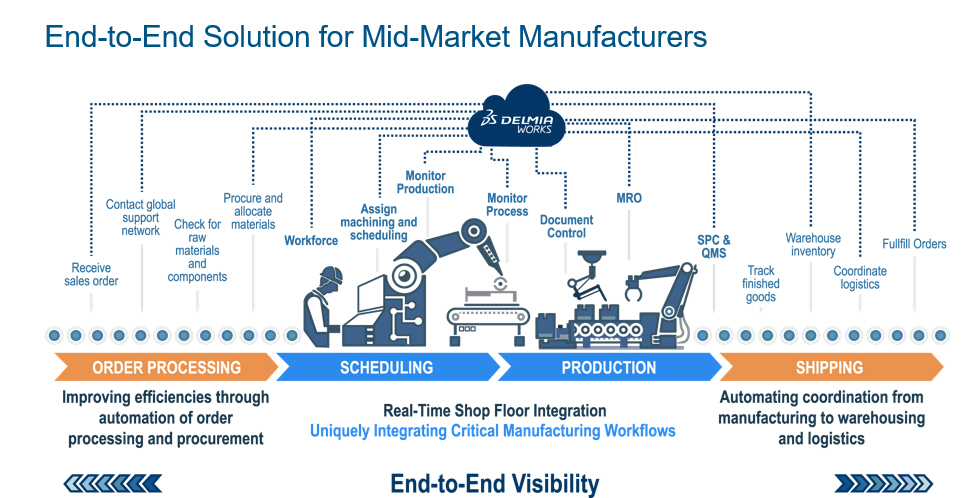If there’s one thing manufacturers want in the near future, it’s stability. However, with COVID-19, a global recession, and political uncertainty, a steady-as-she-goes outlook isn’t in the cards any time soon.
Even before COVID-19, manufacturers faced significant challenges, including global competition, fluctuations in the supply chain, shifts in consumption patterns, and a shortage of skilled workers. Today, the pandemic has exacerbated these issues and brought new challenges to the forefront, including the need to safeguard employees against infection through remote work and social distancing.
What can be predicted is ongoing,
fast-paced change. To cope with this volatility, companies need ERP systems
that enable them to swiftly adapt to emerging conditions. This requires an ERP
with unrivaled flexibility and highly customizable capabilities. Due to these factors,
we’ve seen priorities shift in the ERP selection process with five criteria emerging
high on manufacturers’ requirements:
Real Cloud
Believe it or not, companies are still attempting to navigate between “real” cloud solutions, and those only masquerading as such. This is because some legacy ERP vendors cloaked their solutions to look and sound like a cloud system when it’s really just a hosted version of an on-premises system.
In actuality, these “mock”
cloud solutions have not made any architectural changes to satisfy the
essential characteristics of cloud computing. Instead, they’ve self-proclaimed
their hosted offerings as “cloud” or “SaaS,” hoping to entice those shopping
for a cloud option.
Some legacy ERP
providers have gone a step further, cloud-enabling some portion of their
solution. For instance, they may have added cloud-based point solutions, such
as travel and expense management or time reporting.
Further complicating the
matter is the fact that there is a range of cloud ERP solutions. Some are “more
cloud” than others, meaning they more fully exhibit cloud computing
characteristics.
As a result, the choice
between cloud ERP and hosted ERP is not binary—there’s a range of options, and
a buyer must beware and discern where along the spectrum a vendor’s cloud
offering actually falls.
A Platform Approach
While the benefits of
on-demand, low-maintenance cloud solutions are clear, some companies have
simply gone overboard with too many cloud-based point solutions. The resulting
mish-mash of systems, coined a Frankencloud, can create chaos.
Companies end up with
each cloud solution having different tools for reporting, workflow, and customization.
The clouds have different user interfaces and aren’t easily integrated with one
another. Worst of all, databases are siloed, making reporting and analytics
more difficult. Concepts like a “360° view of the customer” and a “single
version of the truth” are difficult to attain.
To avoid this scenario, companies are now establishing a cloud-platform strategy upfront. Years ago, companies did this by deciding on a technology stack comprising of hardware, operating system,s, and database technology for a unified approach. Similarly, companies today must standardize on a common cloud platform and implement apps on that platform when and where possible. This will minimize integration, data fragmentation, system administration, and the need to manage various toolsets.
For instance, ERP should
reside on the same platform as CRM, so then they can share the same data model.
This works well for manufacturers, as they naturally have a need to share sales
and production information for better forecasts and planning. Combining ERP and
CRM on one platform goes a long way toward simplifying the cloud stockpile,
especially if additional apps and capabilities can be leveraged on the same
platform.
Low-Code Technology
We
started by discussing the importance of customizations to adapt to today’s
volatile conditions. Customization is critical in this environment, especially
as consumption patterns change, supply chains are disrupted, and customers still
demand quality and service. ERP systems can help in all
these areas, but only if it’s fine-tuned to a company’s specific needs.
The trend is that companies want to put more customization in the hands of business users, who are the ones with firsthand knowledge of what’s needed on the front lines to optimize processes and improve customer experience. This is why low-code technology has been emerging as a solution. It gives users customization power because it requires little to no knowledge of software code. Instead, system administrators, power users, and business users can be deemed “citizen developers” within a company. In this role, they can turn a generic system into an ERP uniquely designed for their businesses.
With low-code customization capabilities, they can create screens, mobile apps, workflows, analytic capabilities, and more. Citizen developers can perform these functions because low-code ERP offers a visual approach and drag-and-drop ease of customization. The graphical interface allows citizen developers to draw from a library of tools, data, and process steps when assembling their desired ERP configuration.
For example, low-code lets companies embed predictive analytics and AI into apps and business processes. AI-powered analytics enables business users to automatically discover relevant patterns in the data – without having to build sophisticated models. Within apps, AI can help users determine the next best step to take in a process. In this way, users might spot opportunities, predict outcomes, and get recommendations to improve business outcomes.
Mobilizing ERP
Manufacturers are realizing that mobile apps can help them put ERP capabilities into the hands of frontline workers, customers, and suppliers, and they can even address the need for remote work required during COVID-19.
First, with the low-code customization discussed above, companies can more easily build tailored apps and workflows. Mobile apps essentially make an ERP operate more like a consumer banking app than a complex legacy system. Companies can roll out apps to support a specific function, and these apps are so intuitive that users don’t require much if any, training. For instance, companies can implement the following capabilities via mobile apps:
- Provide sales reps with a
smartphone app with one-tap access to their customers’ most recent orders.
- Give warehouse managers
detailed order information when they’re out on the floor.
- Guide quality-control staff
through an incoming materials inspection.
A low-code ERP vendor delivers mobile app and process flow
templates “out of the box” with the solution. These starter templates can be configured
to a company’s needs and quickly rolled out. In this way, templates become
tailor-made, and companies essentially take an off-the-shelf ERP and make it their
own. Of course, companies can also create their own apps from scratch, but they
have the benefit of business rules and governance guardrails to create within certain
constraints. In this way, they have flexibility, but they also won’t make a
mess of the system.
Building Online Communities for Real-time Communication and Collaboration
Many companies want the ability to quickly launch and bring to life distinct communities of suppliers, customers, distributors, or other trading partners. Low-code can quickly facilitate this type of community online, which is connected to the ERP’s data model. As a result, it’s easy for manufacturers to share appropriate information – such as orders, invoices, or cases – with designated community members.
For example, high-tech products, such as
electronics or computerized devices, are intricate to manufacture – and
managing the supply chain is equally complex. A supply chain organization (SCO)
for such products might require materials from dozens of suppliers around the
world. To efficiently manage interactions and coordinate logistics, the SCO could
use a community builder, which is part of a low-code toolset, to quickly erect an
online supplier community.
The SCO could configure data security, so suppliers
wouldn’t be able to see one each other or one another’s orders. So, supplier A could
only view its orders, not the orders for supplier B, and vice versa. This type
of security is easily configured on the backend, as the SCO defines who sees
what – and what data is kept confidential.
Through the online community, the SCO can also enable suppliers to access dashboards, so they can monitor their own inventory levels and performance. For example, suppliers can see their rate of on-time orders and late shipments, as well as the next orders they should be preparing. Similarly, the SCO can view the health of its overall supply chain.
A Custom-Fit ERP
Manufacturers have been under pressure to do more with less and to satisfy increased customer demands, all of which have been complicated and intensified by COVID-19. Obviously, the needs of a confections company will be different than that of an aerospace manufacturer. A sophisticated ERP vendor recognizes this and has built-in the agility to allow such companies to tailor the system to fit their businesses.
Real cloud ERP built on a common platform offers a single solution to meet today’s challenges — while low-code customization enables companies to more easily roll-out mobile apps, streamline processes, embed AI, and create online communities. Altogether, these capabilities maximize a company’s return on investment. And as market and COVID conditions continue to evolve, companies can adapt accordingly, as they’ll have the technological flexibility to help them do it.
The post Shifting Priorities in ERP Selection appeared first on ERP News.



















